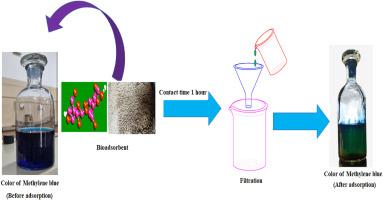Tectona Grandis seed powder and Mangifera Indica leaf powder as bio adsorbents for removal of methylene blue from aqueous solution
引用次数: 0
Abstract
This study intends to describe the use of modified Tectona Grandis seed powder (TG) and Mangifera Indica leaf powder (MI) as adsorbent materials in the process of removing Methylene Blue (MB) from the wastewater. Nitric acid (HNO3) was used to chemically modify the plant material. Thermogravimetric analysis (TGA), Fourier transform infrared spectroscopy (FTIR), scanning electron microscopy (SEM), and X-ray diffraction (XRD) were utilized to analyze the modified bio adsorbents (TG and MI). The adsorbents' ideal specific surface area and pore volume were measured using the N2 adsorption/desorption technique through detailed characterization. The efficiency of the adsorbents in eliminating the MB dye was investigated in relation to the effects of adsorbent dose (2–10 mg), pH (3, 7 and 10), exposure time (10–90 min), temperature (30 °C, 50 °C and 70 °C), and dye concentration (20–100 mg/L) through batch adsorption studies. The models proposed by Langmuir, Freundlich, and Dubinin Raduskevich (D-R) could explain the binding results for MB on TG and MI. The adsorption process were more in line with the Langmuir model than the other models. At neutral pH (7), TG showed maximum percentage removal of 73.12 % whereas, MI powder showed a maximum percentage removal of 50.5 %. Time and adsorbent dosage have both led to an increase in the percentage of methylene blue elimination. The experimental results were confirmed by density functional theory (DFT) calculations, which revealed energy gaps (ΔE) of 4.57 eV and 7.882 eV for MB and TG/MI, respectively. Following complexation, a change of 16.56 eV was observed, indicating a stronger MB adsorption tendency across the modified TG/MI surface. The primary components of the mechanism of MB adsorption include hydrogen bonds, n-π, π-π, and electrostatic interactions, as per the results of Monte Carlo (MC) simulation calculations. According to our findings, TG and MI are affordable biomaterials for treating wastewater in an ecologically responsible and green manner.

作为生物吸附剂从水溶液中去除亚甲基蓝的大叶黄杨种子粉和芒果叶粉
本研究旨在描述在去除废水中的亚甲蓝(MB)的过程中,使用改良的柚木种子粉(TG)和芒果叶粉(MI)作为吸附材料的情况。硝酸(HNO3)用于对植物材料进行化学改性。利用热重分析 (TGA)、傅立叶变换红外光谱 (FTIR)、扫描电子显微镜 (SEM) 和 X 射线衍射 (XRD) 对改性生物吸附剂(TG 和 MI)进行了分析。通过详细的表征,利用 N2 吸附/解吸技术测量了吸附剂的理想比表面积和孔隙率。通过批量吸附研究,考察了吸附剂去除甲基溴染料的效率与吸附剂剂量(2-10 毫克)、pH 值(3、7 和 10)、暴露时间(10-90 分钟)、温度(30 °C、50 °C 和 70 °C)和染料浓度(20-100 毫克/升)的影响。Langmuir、Freundlich 和 Dubinin Raduskevich(D-R)提出的模型可以解释甲基溴在 TG 和 MI 上的结合结果。与其他模型相比,吸附过程更符合 Langmuir 模型。在中性 pH 值(7)下,TG 的最大去除率为 73.12%,而 MI 粉末的最大去除率为 50.5%。时间和吸附剂用量都导致了亚甲基蓝去除率的增加。实验结果得到了密度泛函理论(DFT)计算的证实,计算显示 MB 和 TG/MI 的能隙(ΔE)分别为 4.57 eV 和 7.882 eV。复合后,观察到 16.56 eV 的变化,表明甲基溴在改性 TG/MI 表面有更强的吸附趋势。根据蒙特卡罗(MC)模拟计算的结果,甲基溴吸附机理的主要成分包括氢键、n-π、π-π 和静电相互作用。根据我们的研究结果,TG 和 MI 是一种经济实惠的生物材料,可用于以对生态负责的绿色方式处理废水。
本文章由计算机程序翻译,如有差异,请以英文原文为准。
求助全文
约1分钟内获得全文
求助全文

 求助内容:
求助内容: 应助结果提醒方式:
应助结果提醒方式:


